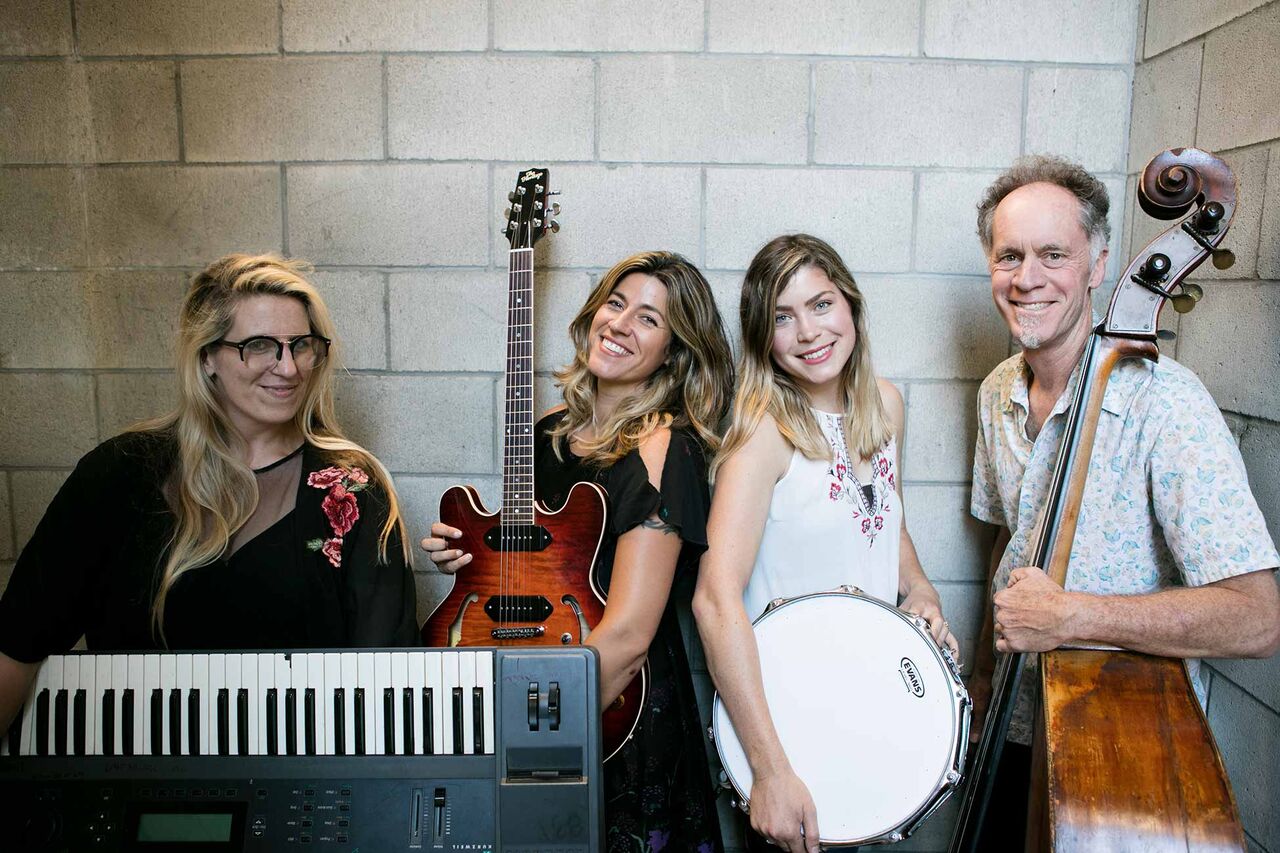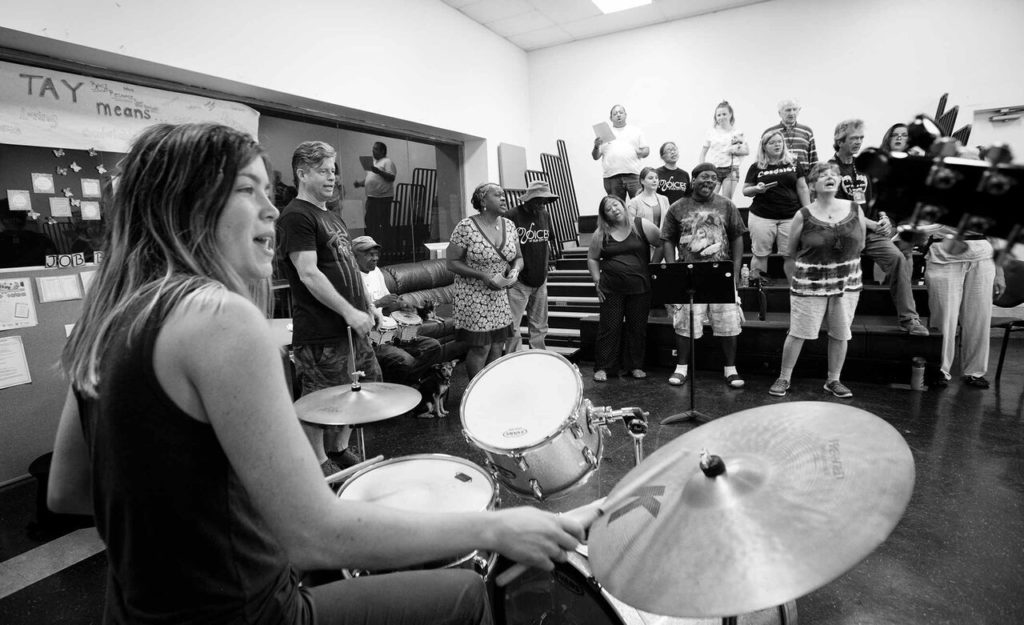By Leah Bowden
Header photo by: Michele Zousmer
Voices of Our City Choir (VOOC) is a collaboration between professional musicians, people experiencing homelessness in San Diego, and a larger community support network. Coming together in a collective attempt to chart a course through the harsh realities of homelessness and austerity politics, the choir is an ambitious performing group, appearing at major music venues across Southern California. Their work has received regional and national press, including coverage on PBS NewsHour and NPR. In this special feature for Tom Tom, VOOC drummer Leah Bowden tells the story of the band behind the choir’s sound and mission. Her bandmates, Nina Leilani Deering (keys), Steph Johnson (guitar), and Rob Thorsen (bass), discuss the rewards and challenges of building music through music and social action.
The summer of 2016 in San Diego was marked by a series of intense heat waves in the midst of an intensifying homelessness crisis. My musician friends Nina Deering and Steph Johnson called me one day to help distribute food, water, and bandanas to hundreds of people living on the streets downtown. They had teamed up with, among others, activists Jeeni Criscenzo of Amikas, an organization that creates and provides housing for homeless women and children, and Martha Sullivan of the progressive community activist group Grassroots Oasis. Together, they were spreading the word about a series of aggressive city policies directed at unsheltered people. This included public restroom closures, the installation of “anti-homelessness” rocks in place of where people slept, and of course the infamous “homeless sweeps”—when a person’s tent and belongings are discarded while the person is ticketed or arrested. The city also ordered nonprofits to stop feeding the poor during the weeks leading up to major tourist events, Comic-Con and the Major League Baseball All-Star Game, hoping that homeless people would simply leave.
By the time I got involved, Johnson and Deering had already spent a great deal of time getting to know our unsheltered neighbors. They had become acquainted with their struggles and passions and found that many of the homeless people they met were also musicians, songwriters, and singers. Meanwhile, Pastor Chris Nafis of Living Water Church of the Nazarene noticed the outreach efforts of Johnson and Deering and offered access to a nearby community center, where he had established a ministry tailored to the needs of the homeless population. This invitation created an opportunity to establish a strong presence in a neighborhood located at the heart of the homelessness crisis. As Johnson recalls, “We saw a desperate need for a respectful, creative environment where new ideas and potentials could be realized.” Imagining a space free from aggressive policing and the harsh conditions of living on the street, Johnson said to Deering, “How would you feel about starting a choir?” They immediately began inviting their new friends to attend weekly rehearsals at Nafis’ community center. This was the seed that grew into Voices of Our City Choir.
“It’s not just singing in practice; it’s tapping into a place in your body that needs to be released for healing.”
Joy, hope, and self-confidence are not qualities one expects to see reflected in the faces of those who are living on the streets. However, when audiences witness Voices of Our City Choir, they are invited to share in a moment of collective self-realization, validation, and purpose. Grounded in pride and ownership of each lyrical phrase, the choir projects a sense of belonging—signifying emotional transformations that have taken place in recent months. These are the sounds of community, of healing, and solidarity—harmonies built upon a broad network of meaningful human connections. The fellowship among choir members and this renewed passion for life rises to the surface of the sound. An invitation to experience the gifts of others emerges as the boundaries between the sheltered and unsheltered are dissolved in a musical performance that seeks to both recognize and resurrect a shared humanity.
Shortly after we started meeting at the community center, our friend Rob Thorsen, one of the most in-demand bassists on the West Coast and an advocate for jazz programs for underserved youth, started showing up with his bass. I rolled in with my drums, ready to raise the vibration with anything the music might call for—from hard-hitting funk and hip-hop beats to subtle rubato textures, accents and effects. With Deering’s keys and Johnson’s guitar, we had a full backing band of professional musicians collectively experienced in jazz, Latin, soul, choral, and gospel, among other styles of music.
Deering and Johnson selected material with uplifting and socially conscious lyrics, such as Gregory Porter’s “No Love Dying Here” and Marvin Gaye’s “What’s Going On.” In regular choir rehearsals and separate band sessions, we began workshopping melody, groove, dynamics, layering, and interlocking parts. Through this process, we developed arrangements that would form the backdrop of VOOC’s sound. More recently, we have been working with the choir members to develop original material that showcases their collective abilities as songwriters, composers, and performers.

Maintaining a polished backing band has proved itself vital; the singers can really shine over a solid, dynamic foundation. As Thorsen puts it, “The band is all about the groove. When the beat hits, I see this immediate transformation of people leaving behind whatever problems are plaguing them. They lose all of their inhibitions.” The choir itself, although well rehearsed, does not necessarily strive to sound “refined.” Johnson describes the sound as raw and visceral. As she explains, “It’s not just singing in practice; it’s tapping into a place in your body that needs to be released for healing. When we first met many of our choir members, they were literally trying to kill themselves. They had no reason to live. And now, when they sing, they reveal a connection to life-force energy; which you could call soul or soulful singing. They’ve been reacquainted with their own self-purpose and that has a sound. It is so charged.”
Deering directs the choir and leads rehearsals. She covers methods of healthy vocal production and teaches harmony parts by ear. As Deering explains, “The beating heart of choir is that we rehearse and perform regularly.” Johnson agrees, adding, “Not only are our vocal warm-ups literally warming up our vocal cords, but Deering will pose questions such as ‘What are you great at?’ or ‘What are you looking forward to?’ And that’s one of the ways we create the fabric of our relationship with the choir.” This process helps provide routine and a safe space where people can come inside for a while, get something to eat and drink, use a restroom, and make a friend—basic things that sheltered people often take for granted.
Being together and in the moment during choir practice is part of how we are maintaining a commitment to solidarity as we bear witness and build resistance to the bitter and hollowed-out remains of the neoliberal city. As Deering points out, “As choir director, I have this great honor to have the attention of this whole cross section of life, and to ask them, ‘What’s real? How can we help each other? How can we encourage the artistry of the other?’ It seems like such a new concept to people that everyone is an artist, but everyone has their art form—whether it’s organizing people, singing, loving, healing. These are positive ways of dealing with the frustrations of modern life; this eternal human condition.”
“Remember to breathe. Be cool, be calm, be confident. Mean what you say.”
For myself, it’s long been my dream to work with a group as thoroughly integrated as Voices of Our City. We engage people from diverse ethnicities, genders, ages, and radically differing life experiences. As artists, we often find ourselves in a consciously marginal social and economic reality that has parallels with others experiencing precarious living conditions. Without conflating the conditions of being an artist with the historical and objective conditions of poverty, artists are often aware and motivated to represent the poorest and most vulnerable among us. Thorsen observes, “Partly because of the political climate that we are living in right now, a lot of people are coming together. We as artists and as people are more aware of the growing homeless problem. People are being displaced truly in many cases through no fault of their own. As musicians, we have banded together to help serve the community, and in turn, there’s more awareness about the problem and about potential solutions. Our way of dealing with it is through music.”
Johnson has released four critically acclaimed solo albums and has toured extensively. However, she finds herself in awe at the energy and intensity with which audiences respond to Voices of Our City performances. “People come alive with joy, and awareness,” Johnson says. “They get up in their seats. They are crying. It’s an awakening.” Deering calls this a “cracking open of those who have been hardened by the circumstances of life.” She argues that this process of sharing creative energy is a vital tool for peace in local communities and beyond.
Deering describes our sound as both the achievement of harmony in a musical sense, as well as a direct parallel to the human harmony that we are striving toward as a humanitarian organization by standing together and singing through our frustrations, joys, and pains. That synchronicity is not because we are the best musicians or we are getting the best gigs, etc.; it’s because we are all part of this emotional revelation, and we are all repurposing ourselves to be that vehicle. And everyone is invited to take part.” Deering’s rules of singing, often recited during choir practice, also suggest a way of being in the world: “Remember to breathe. Be cool, be calm, be confident. Mean what you say.”
This article was featured in the Outlaw issue of Tom Tom. Purchase it online.


